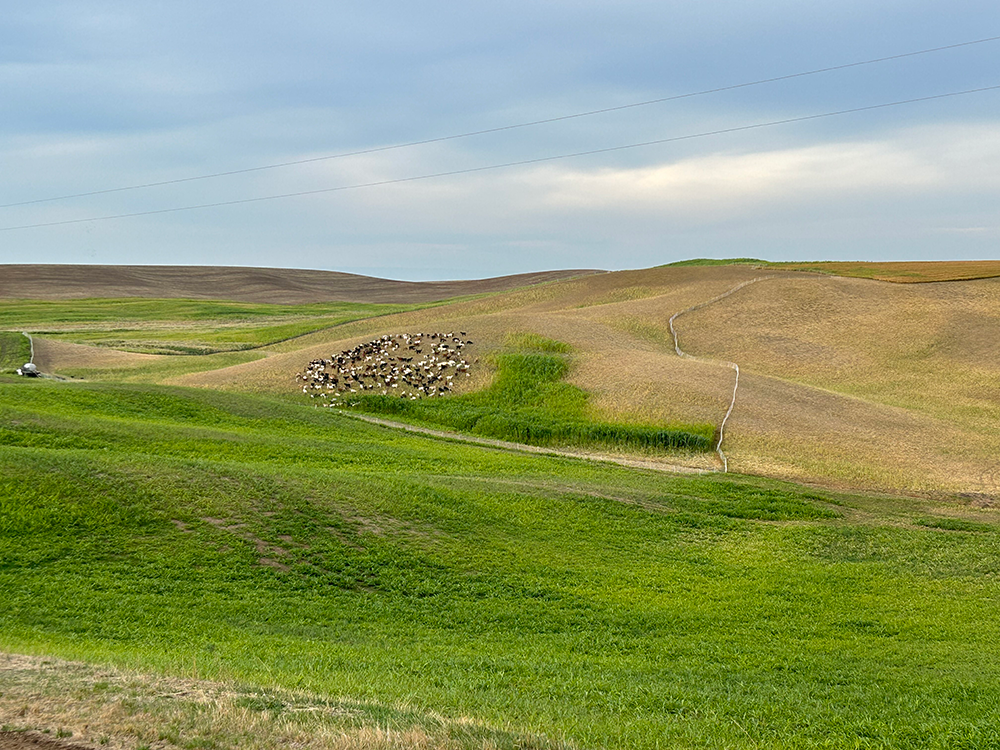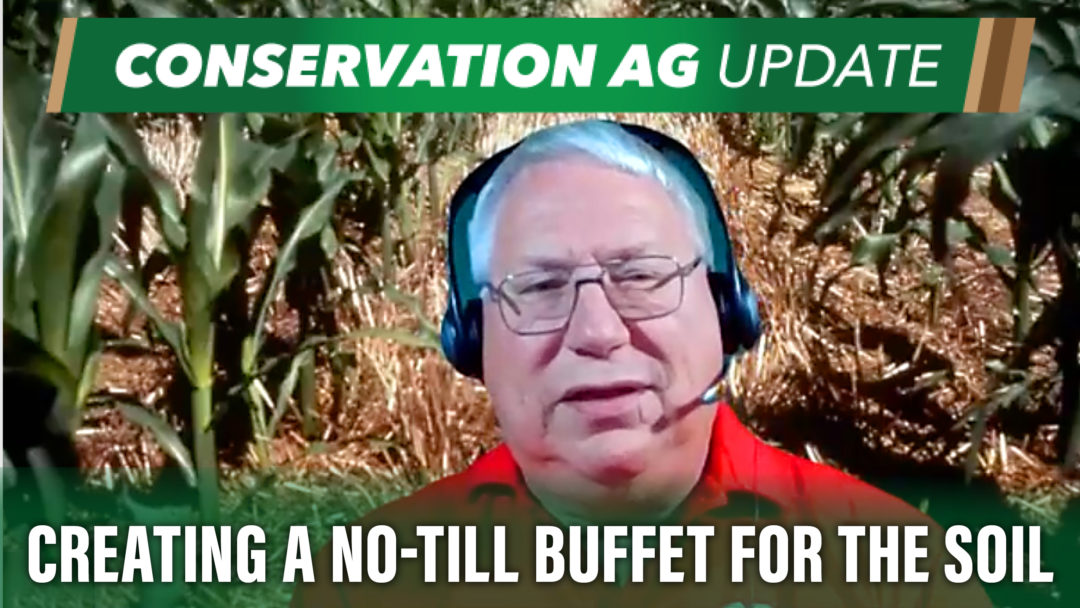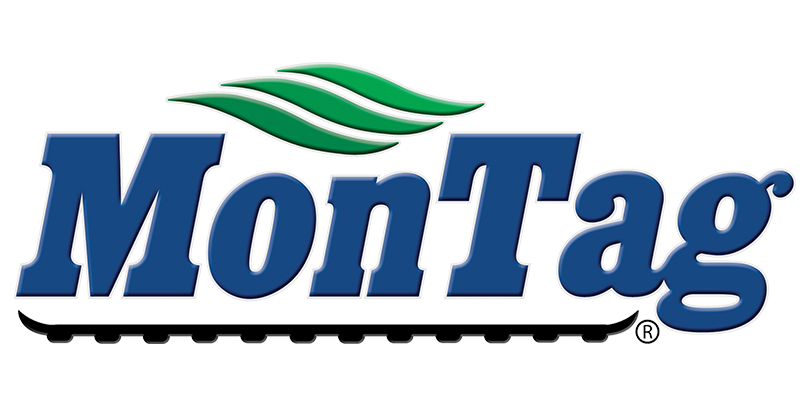On this episode of Conservation Ag Update, brought to you by Montag Manufacturing, no-till legend and 2024 National No-Tillage Conference speaker Paul Jasa explains why a diverse rotation is a key part of his systems approach to no-till.
In the Farmer Feature segment, we go inside the cab with Elkhorn, Wis., grower Adam Friemoth, as he custom combines a no-tiller’s corn crop. Friemoth talks about how his conventionally tilled soybeans compared to no-till soybeans that he harvested in 2023 and shares tips for harvesting corn and maximizing the combine’s fuel efficiency.
We visit with Brandon, Minnesota, no-tiller John Ledermann in the Cover Crop Connection. Lederman showcases his unique strategy for planting cereal rye and corn.
Plus, strip-tiller David Hula reflects on his record-breaking 623-bushel corn yield, Sentinel Fertigation founder Jackson Stansell shows how N-Time is saving growers an average of 42 pounds of nitrogen per acre, and a grower from Idaho grazes 800 goats on 195 acres of cover crops.
This episode of Conservation Ag Update is brought to you by Montag Mfg.
Montag Manufacturing has rolled out two new industry-first products. Cover Crop Plus is the first metering system dedicated to cover crop seeds, able to accurately meter even the smallest seeds like cover cress. It can be mounted to tillage implements, combines and self-propelled high clearance machines.
The second new product is the mammoth sized model 2224 with 13 or 16 tons capacity for producers running with larger strip-till implements. For more information, visit the Montag website or your Montag dealer.
TRANSCRIPT
Jump to a section or scroll for the full episode...
- A Systems Approach to No-Till & Soil Health
- Farmer Feature: Adam Friemoth, Elkhorn, Wis
- Cover Crop Connection: Planting 2 Rows of Cereal Rye & 1 Row of Corn
- David Hula Reflects on Record-Breaking 623-Bushel Yield
- Ahead of the Curve: N-Time Improves Nitrogen Use Efficiency by 25%
- Photo of the Week: Goats Grazing Cover Crops
A Systems Approach to No-Till & Soil Health
Welcome to the first Conservation Ag Update of 2024. Hope everyone enjoyed the holidays. Very exciting week ahead, as the 32nd annual National No-Tillage Conference kicks off in Indianapolis. The Super Bowl of No-Till will feature presentations from innovators like Paul Jasa, who’s been studying no-till for nearly 50 years! Paul’s going to be talking about a systems approach to soil health, and the benefits of a diverse rotation, as he explains to our Mackane Vogel here… take a listen.
“The more diversity you get in the rotation, the better you're going to feed the soil system. That's where a lot of producers now are relying on cover crops to do that for them. As for instance, I've got a set of research glyphosate in corn-soybean rotation for a number of years, I seeded cover crop of cereal rye and Austrian winter peas. The corn and the wheat, or I'm sorry, the cereal rye are both grasses; one cool season, one warm season. The Austrian winter peas and soybeans are both legumes; one cool season, one warm season. I've got all four crop types in a real simple corn-soybean rotation, actually oscillation, with their rotation effect coming from the cover crop as well. Again, when it comes to the diversity, if it's not in your cash crops, put it in your cover crops. It's just like you and I when we go to the buffet at a restaurant, we don't eat all on the salad bar, we don't eat all on the meat course, we like a variety of things. Well, so does our soil, our soil microbes. We want to feed it a variety of systems.”
Looking forward to hearing more from Paul next week. Still time to sign up, head to NoTillConference.com if you’re interested.
Farmer Feature: Adam Friemoth, Elkhorn, Wis.
We’re going inside the cab for this week’s Farmer Feature. Managing editor Michaela Paukner did a ride-a-long with Elkhorn, Wis., grower Adam Friemoth, as he was custom combining a no-tiller’s corn crop. He talks about how his conventionally tilled soybeans compared to no-till soybeans that he harvested in 2023.
“I would say for the most part our soybeans weren't that great. I did do some soybeans for a friend of mine that were no-till it was a longer day beans. So, I don’t know if that had something to do with it. Then everything else we were running, but it was five to six bushels better. That's kind of what I planted. One variety of 2.9 beam he had, which our area that's really long and I had about that same four to five better.”
Adam also shared some tips for harvesting corn and maximizing the combine’s fuel efficiency.
“It's a John Deere head and it's a folding chopping. So, this is meshing rolls. So, they work like a gear. Okay. Some of them are knife to knife. I don't like those because they don't seem to last as long. These, when they're wore out, you can still be using them because it grabs the stalk better where the knife to knife, as soon as that wears out, it doesn't pull them through.
“And how often do you have to replace that?”
“Every four years. And they're 5,500 bucks a roll and there's 24 of them. There's $550 a roll and there's 24 of them on the head. So, it gets expensive fast.
“Try to do this on the move because we're burning 11 gallons of fuel an hour right now just on unloading. Which doesn't seem like long, but throughout the day if you do this a lot, you waste a lot of fuel quickly.
“I would say most of the time while we're picking, I have the stalk shredders turned or the chopping part turned off, so we're probably saving three, four gallons an hour on that. But otherwise not 22 to 24 gallons an hour.”
Planting 2 Rows of Cereal Rye & 1 Row of Corn
Mackane Vogel here, with this week’s cover crop connection. I had the opportunity to visit with Brandon, Minnesota farmer John Ledermann and check out his unique strategy for planting cereal rye and corn.
“This is 2 rows of cereal rye and then here’s my clear row. So, I did this with the drill. And I guess the way I’ve got it, I am putting fertilizer down at the same time. So, you can figure, I run 22 inch rows, so, I got 3 rows — 2 rows of cereal rye and 1 without. And what I do is I kind of break my fertilizer like — it would be in 4 parts. So, 1 part would go here, 1 part would go here and then 2 parts would go here where the corn row is going. So then, the drill area again is frozen, but the drill kind of makes almost a little bit of a strip there, so, my theory is just get a little more fertilizer by the corn row, but hopefully not too much that I burn it. I shoot for 3 inches deep with this row, but you know, sometimes it is hard in the fall. You don’t always get that 3 inches.”
Ledermann says he’d like this strategy to be done on all of his corn acres, but time doesn’t always allow for it. This past season he was able to plant about a quarter of his corn acres using this strategy and he says that those acres were easier to plant despite the extra time it takes. That’s all for this week’s cover crop connection.
David Hula Reflects on Record-Breaking 623-Bushel Yield
David Hula’s done it again. In case you missed it before the holidays — The Charles City, Va., strip-tiller set a new corn yield record of 623.84 bushels per acre.
He’s the only farmer in NCGA yield contest history to break the 600-bushel barrier, and this is now the third time he’s done it. He planted a Pioneer 114-day hybrid designed for the dry grind ethanol market. Hula added 575 pounds of nitrogen, 156 pounds of phosphorous, 480 pounds of potassium, 12 pounds of boron and 80 pounds of sulfur per acre spread across the growing season.
“When we were looking at the P14830 as something to put into our high yield environment, the thing that really attracted our attention was the ear placement on that corn as well as the plant height. And then to have it perform just like they had projected, that just goes to give me that extra bit of confidence when we started thinking about buying seed for next season.”
Hula shared some of the keys to growing a high-yielding crop at last year’s National No-Tillage Conference. Check out the recap on No-TillFarmer.com
Ahead of the Curve: N-Time Improves Nitrogen Use Efficiency by 25%
Time now to go Ahead of the Curve, and this week we’re spotlighting a product that saved growers an average of 42 pounds of nitrogen per acre. It’s called N-Time from Sentinel Fertigation. Company founder Jackson Stansell shows us how it works.
“It’s really tailored to those who are applying fertilizer in season. What we do is we ingest satellite imagery from two difference sources. We primarily rely on near daily satellite imagery from Planet. We analyze that satellite imagery to isolate the impact of nitrogen on yield potential, quantify a nitrogen sufficiency index that puts a number on nitrogen and ultimately provides a 7-day crop demand for nitrogen outlook. We then turn those into recommendations to either apply or not apply more nitrogen fertilizer, provide a rate prescription for the application to make it tailored to your crops’ actual yield potential in season. We don’t require yield goals, we don’t require estimated nitrogen apply. This software has been proven to improve nitrogen use efficiency by 25% vs. what farmers are doing today, giving great opportunities for profit and productivity improvement.”
Photo of the Week: Goats Grazing Cover Crops
And let’s wrap up the program with the photo of the week. This one comes to us from Eric Odberg in Genesee, Idaho.

He says 2023 was year one of his dive into regenerative agriculture on the Palouse, where he doesn’t see a lot of cover crops being used. He grazed 800 goats on 195 acres of cover crops, which you can see in the distance there. He didn’t specify the species, but he says the covers worked well in a fairly dry year. He’s planning on using canola next spring, with hopes of getting a lot of organic nitrogen from it.
Have an interesting photo or video from your farm? Or a story you’d like us to feature on the broadcast? Send me an email at Nnewman@lesspub.com.
And that will wrap things up this edition of Conservation Ag Update. Until next time, for more stories visit no-tillfarmer.com, striptillfarmer.com and covercropstrategies.com. Thanks for stopping by. Have a great day!









Post a comment
Report Abusive Comment